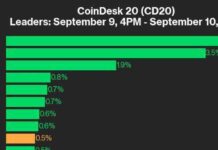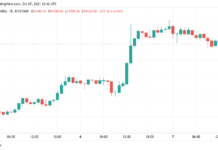Bitcoin is facing pressure as traditional asset classes like stocks, bonds, and gold surge amid a global monetary stimulus campaign. While most financial markets are experiencing an uptrend due to coordinated easing measures by major central banks, bitcoin has failed to join the rally.
Central banks in the Western world, including the Federal Reserve, the European Central Bank, the Bank of England, and the Bank of Canada, have all initiated rate cuts to stimulate their economies. The Fed is expected to follow suit with its first easing cycle since 2019, possibly cutting its benchmark lending rate by either 25 or 50 basis points. This monetary easing has led to record highs in the S&P 500 and Nasdaq, falling U.S. Treasury yields, and soaring gold prices.
Despite the positive trend in traditional markets, bitcoin has struggled to gain momentum. While the cryptocurrency saw a rally on Friday, its price remains below $60,000 and is approximately 20% lower than its all-time high of over $73,500 six months ago. This underperformance has raised concerns among bitcoin bulls who were hoping for a new bull run.
Zooming out, bitcoin has still shown significant gains year-to-date, with a rise of over 40% and 127% from year-ago levels. However, its performance compared to U.S. stocks and gold over the past few months has been lackluster. Bitcoin’s price is significantly lower than its peak three years ago, despite rapid inflation during that period. This has led some investors to question bitcoin’s ability to serve as an effective inflation hedge.
Historically, bitcoin has not responded strongly to rate cutting cycles, with only one significant rally following the Fed’s monetary easing in 2019. It wasn’t until the Covid-era monetary push in March 2020 that bitcoin began its meteoric rise. Some experts suggest that minor rate cuts may not be enough to spark a new bull run for bitcoin, and more drastic central bank measures may be required.
Overall, the current market conditions highlight the challenges facing bitcoin as it struggles to keep up with traditional asset classes in a period of global monetary stimulus. While the cryptocurrency has shown resilience and significant gains in the past, it remains to be seen whether it can regain its momentum in the face of ongoing economic uncertainties.
Impact of Monetary Easing on Bitcoin
The recent surge in traditional asset classes like stocks, bonds, and gold can be attributed to the coordinated monetary easing measures undertaken by major central banks. As these institutions lower interest rates and implement quantitative easing programs, investors seek out alternative assets to protect their wealth and hedge against inflation.
Bitcoin, often touted as “digital gold” or a store of value, has failed to capitalize on this trend. Despite its reputation as a safe haven asset, the cryptocurrency has struggled to maintain its value in the face of economic uncertainties. This raises questions about bitcoin’s ability to fulfill its role as a hedge against traditional financial risks.
While some investors remain optimistic about bitcoin’s long-term potential, others are skeptical of its ability to withstand the volatile market conditions. As central banks continue to implement stimulus measures, the cryptocurrency may face further challenges in gaining traction among mainstream investors.
Challenges and Opportunities for Bitcoin
The current market environment presents both challenges and opportunities for bitcoin. On one hand, the cryptocurrency has shown resilience and significant gains in the past, indicating its potential to thrive in uncertain economic times. On the other hand, bitcoin’s underperformance compared to traditional assets raises concerns about its long-term viability as an investment option.
To regain investor confidence and attract new capital, bitcoin may need to demonstrate its ability to serve as a reliable store of value and a hedge against inflation. This requires a combination of market stability, regulatory clarity, and widespread adoption to position bitcoin as a mainstream asset class.
As central banks continue to implement monetary easing measures, bitcoin’s response to these policies will be closely watched. Whether the cryptocurrency can outperform traditional assets and establish itself as a legitimate investment vehicle remains to be seen. In the meantime, investors are advised to monitor market trends and assess the risks associated with investing in bitcoin.
In conclusion, the current market dynamics highlight the challenges facing bitcoin as it struggles to keep pace with traditional asset classes amid global monetary stimulus. While the cryptocurrency has shown resilience in the past, its performance in the face of economic uncertainties remains uncertain. Investors should carefully evaluate the risks and opportunities associated with investing in bitcoin, taking into account its historical performance and potential for future growth.














